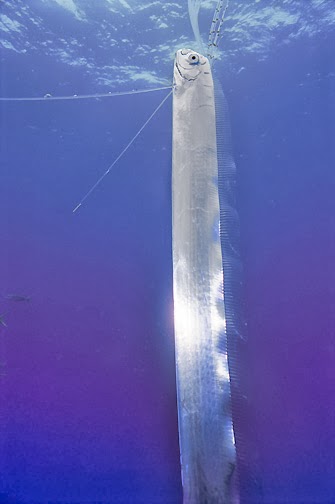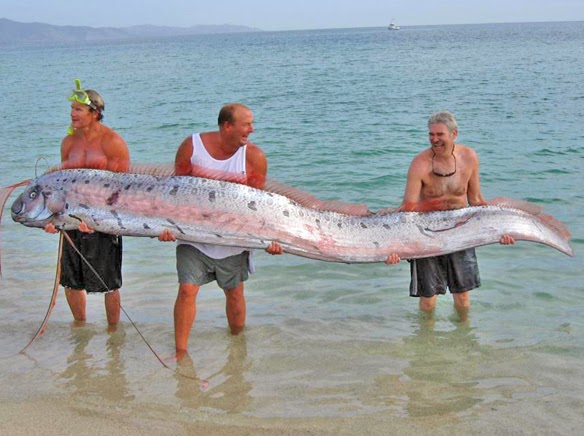I will attempt to put these is order to go to my most favorite.
To start...
#15 The Blob Fish (Psychrolutes marcidus)
Found off the coast of New Zealand and Australia at depths between 2 and 4 thousand feet where it feeds on crustaceans and invertebrates. This fish has a mostly gelatinous body that is perfect for the high pressure, deep ocean.
#14 Anglerfish (order Lophiiformes)
What we commonly call the anglerfish is a large group of fish and the iconic image is the female. Male anglerfish are tiny and rather cute. Anglerfish have all sorts of weird habits including their luminescent lures and their method of reproduction, where the male bites the female's side and slowly merges with her body. Anglerfish is a broad term for many kinds of deep sea fish including anglers, sea toads and coffinfish.
 |
| Female Angler |
 |
| Male Angler, rather cute isn't he. |
#13 Long Nosed Chimera (Rhinochimaeridae)
A Pacific species of cartilaginous fish that little is known about. One of the deepest ranging fish being found up to 6000+ ft below the surface. These fish have a myrid of sensory organs on their snout and a venomous dorsal spine.#12 Viperfish (Chauliodus)
These vicious predatory fish use photophores to attract unwitting prey at depths of up to 5,000 ft. Their hinged lower jaw and teeth too long to close their mouth without them curving back over their head are used to subdue prey.
#11 Deep Sea Hatchetfish (Sternoptychinae)
Not to be confused with the freshwater hatchetfish some have in their aquariums. This fish wins when it comes to creepy eyes. Hatchetfish are found in most warm water oceans all around the world. Known for their silvery scales and compressed bodies they live up to 5,000 ft below sea level. Like many deep sea fish they are also luminescent.
#10 Gulper Eel (Saccopharyngiformes)
Named for the huge gape of its mouth and its ability to swallow fish much larger than its head the gulper eel is truly bizarre looking. These amazing eels can live up to 10,000 ft below the ocean surface. They are poor swimmers but will swallow any animal daring to get close enough to check out its luminescent tail.
#9 Pacific Black Dragon (Idiacanthus antrostomus)
An almost snake looking deep sea fish with large fang like teeth and spots of luminescence the Black dragon occurs in the Pacific Ocean below 1,300 ft. Like the angler, the females are what we see. Males have no stomachs and only live long enough to breed.
#8 Japanese or Giant Spider Crab (Macrocheira kaempferi )
These crabs with an amazing leg spread of up to 12 ft live at depths of 1,200 ft or shallower. Found mostly off the Southern coast of Japan these crustaceans have been known to injure people and damage property with their strong, sharp claws.
The vultures of the sea. These fish are scavengers and feed on all manner of dead animals. Known for producing a large amount of oozy slime as a defensive mechanism these living fossil, jawless fish are found at many depths on the ocean floor.
#6 Frilled Shark (Chlamydoselachus anguineus)
Considered a living fossil this shark is found at 600-5,000 ft below sea level and named for the ruffled appearance of its gill slits. Found in patchy areas across both the Pacific and Atlantic Ocean there is some consideration that these sharks may have helped the myths of sea serpents sprout up around the world. It has a long snake like body and often coils and lunges with its body to capture prey, much like a snake.
# 5 Giant Isopod (Bathynomus)
These giant relatives of crabs, shrimp and our humble land pillbugs can live at depths up to 7,000+ feet. Primarily scavengers these crustaceans are products of deep sea gigantism and are believed to be found in all the world oceans.
#4 Vampire Squid (Vampyroteuthis infernalis)
Likely has one of the best scientific names which translates into the Infernal Vampire Squid. Named for the fang like protrusions on its arms, instead of suckers, the vampire squid is one of the smaller squid species, maxing out around 1 ft. This squid species can be found at depths of 3,000 ft or more where it preys on fish and other animals.
#3 Coelacanth (Coelacanthiformes)
Another of the living fossils found primarily in the Indian Ocean around a depth of 1,600 ft. These fish represent a group of lobe-finned fish that gave rise to tetrapods, those animals with four limbs, making this fish one of our oldest living ancestors
# 2 Giant and Colossal Squid (Architeuthis and Mesonychoteuthis hamiltoni)
The largest cephalopods in the ocean, that we know of, these are truly the stuff of legend. Colossal Squid can be as long as a school bus, live under the Antarctic Ice at depths of 6,000 ft and sport suckers with razor sharp hooks. Giant squid can measure up to 43+ feet, females are larger than males, and live at depths of 3,000 ft or more where they feed on fish and other organisms.
 |
| Colossal Squid |
 |
| Giant Squid |
 |
| Giant Squid |
 |
| Sucker hooks of the Colossal Squid |
#1 And Finally my favorite the Oarfish. (Regalecidae)
The most probable reason for sea serpent myths the Oarfish, these up to 36+ ft long fish can be found in most temperate and tropical waters up to 3,000 feet below the surface. Despite their size oarfish feed mostly on crustaceans, shrimp and small invertebrates.
Want more deep sea creatures? Check out these links:
Long Nosed Chimera
Giant Squid (Deep Sea Portal is an awesome site)
Frilled Shark
List of Terrifying Deep Sea Creatures
The Oarfish
Sea and Sky Deep Sea Creatures
Video of the Deep Sea Oarfish
Video of Deep Sea animals including the Giant Squid
The most probable reason for sea serpent myths the Oarfish, these up to 36+ ft long fish can be found in most temperate and tropical waters up to 3,000 feet below the surface. Despite their size oarfish feed mostly on crustaceans, shrimp and small invertebrates.
Want more deep sea creatures? Check out these links:
Long Nosed Chimera
Giant Squid (Deep Sea Portal is an awesome site)
Frilled Shark
List of Terrifying Deep Sea Creatures
The Oarfish
Sea and Sky Deep Sea Creatures
Video of the Deep Sea Oarfish
Video of Deep Sea animals including the Giant Squid





























No comments:
Post a Comment